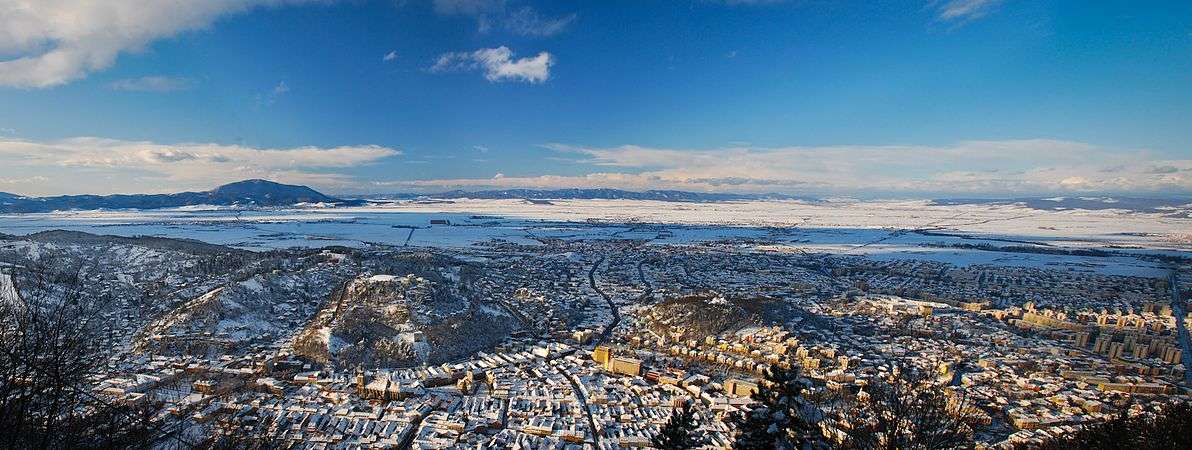Brașov
Brașov (UK: /bræˈʃɒv/, US: /brɑːˈʃɔːv, -ɔːf/,[4][5][6] Romanian: [braˈʃov] (![]()
Brașov | |
|---|---|
 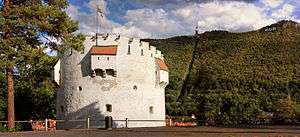 Council Square (top), Tâmpa Mountain seen from the White Tower (bottom) | |
 Flag  Coat of arms | |
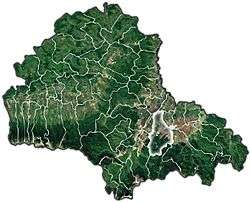 Location in Brașov County | |
 Brașov Location of Brașov within Romania | |
| Coordinates: 45°40′N 25°37′E | |
| Country | |
| County | |
| Status | County capital |
| First mentioned | 1235 |
| Government | |
| • Mayor | George Scripcaru[1] (Ind.) |
| Area | |
| • City | 267.32 km2 (103.21 sq mi) |
| • Metro | 1,368.5 km2 (528.4 sq mi) |
| Elevation | 538 m (1,765 ft) |
| Population (2011-10-31)[2] | |
| • City | 253,200 |
| • Estimate (2016)[3] | 290,743 |
| • Metro | 382,896 |
| Demonyms | brașovean, brașoveancă |
| Population by ethnicity | |
| • Romanians | 91.2% |
| • Hungarians | 7.9% |
| • Germans (Transylvanian Saxons) | 0.5% |
| • Roma | 0.4% |
| Time zone | UTC+2 (EET) |
| • Summer (DST) | UTC+3 (EEST) |
| Postal code | RO 500xxx |
| Area code(s) | (+40) 268 |
| Vehicle registration | BV |
| Website | www |
According to the latest Romanian census (2011), Brașov has a population of 253,200 making it the 7th most populous city in Romania. The metropolitan area is home to 382,896 residents.[7]
Brașov is located in the central part of the country, about 166 kilometres (103 miles) north of Bucharest and 380 kilometres (236 miles) from the Black Sea. It is surrounded by the Southern Carpathians and is part of the historical region of Transylvania.
The city is notable for being the regional capital of the Transylvanian Saxons of the Burzenland (Romanian: Țara Bârsei) administrative area in the past, and a large commercial hub on the trade roads between East and West. It is also the birthplace of the national anthem of Romania.
Etymology
Corona, Kronstadt
According to Balázs Orbán, the name Corona – a Latin word meaning "crown" – is first mentioned in the Catalogus Ninivensis in 1235 AD, stating a monastic quarter existed in the territory of the Roman Catholic Diocese of Cumania (In Hungaria assignata est paternitas Dyocesis Cumanie: Corona).[8] Pál Binder supposing it is a reference to the St. Catherine's Monastery. Others suggest the name derives from the old coat of arms of the city, as it is symbolized by the German name Kronstadt meaning "Crown City". The two names of the city, Kronstadt and Corona, were used simultaneously in the Middle Ages, along with the Medieval Latin Brassovia.
Brassovia, Brassó, Brașov, etc.
According to Dragoș Moldovanu, the name of Brașov came from the name of local river named Bârsa (also pronounced as "Bărsa") that was adopted by Slavs and transformed to Barsa, and later to Barsov, finally to Brasov.[9] According to Pál Binder, the current Romanian and the Hungarian name Brassó ([ˈbrɒʃʃoː]) are derived from the Turkic word barasu, meaning "white water" with a Slavic suffix -ov.[10] Other linguists proposed various etymologies including an Old Slavic anthroponym Brasa.[11][12] The first attested mention of this name is Terra Saxonum de Barasu ("Saxon Land of Baras") in a 1252 document issued by Béla IV of Hungary.[8] According to some historians, Corona was name of the city-fortress while Brassó was referring to the county, while others consider both names may refer to the city and the county as well.
Stephanopolis, Orașul Stalin
Another historical name used for Brașov is Stephanopolis,[13] 'from "Stephanos", crown, and "polis", city.
From 1950 to 1960, during part of the Communist period in Romania, the city was called Orașul Stalin (Stalin City), lit. "Stalin City", after the Soviet leader Joseph Stalin.[14]
Geography
Climate
Brașov has a humid continental climate (Köppen climate classification: Dfb).
| Climate data for Brașov | |||||||||||||
|---|---|---|---|---|---|---|---|---|---|---|---|---|---|
| Month | Jan | Feb | Mar | Apr | May | Jun | Jul | Aug | Sep | Oct | Nov | Dec | Year |
| Average high °C (°F) | −0.3 (31.5) |
1.7 (35.1) |
7.6 (45.7) |
14.0 (57.2) |
19.2 (66.6) |
22.1 (71.8) |
24.0 (75.2) |
23.9 (75.0) |
20.3 (68.5) |
14.5 (58.1) |
7.2 (45.0) |
1.5 (34.7) |
13.0 (55.4) |
| Daily mean °C (°F) | −4.3 (24.3) |
−2.3 (27.9) |
2.6 (36.7) |
8.3 (46.9) |
13.4 (56.1) |
16.4 (61.5) |
18.1 (64.6) |
17.8 (64.0) |
14.2 (57.6) |
8.7 (47.7) |
3.1 (37.6) |
−1.9 (28.6) |
7.8 (46.1) |
| Average low °C (°F) | −8.3 (17.1) |
−6.2 (20.8) |
−2.3 (27.9) |
2.6 (36.7) |
7.6 (45.7) |
10.8 (51.4) |
12.3 (54.1) |
11.8 (53.2) |
8.1 (46.6) |
3.0 (37.4) |
−1.0 (30.2) |
−5.2 (22.6) |
2.8 (37.0) |
| Average precipitation mm (inches) | 31 (1.2) |
28 (1.1) |
30 (1.2) |
50 (2.0) |
79 (3.1) |
97 (3.8) |
94 (3.7) |
73 (2.9) |
49 (1.9) |
38 (1.5) |
36 (1.4) |
32 (1.3) |
637 (25.1) |
| Source: [15] | |||||||||||||
History
The oldest traces of human activity and settlements in Brașov date back to the Neolithic age (about 9500 BCE). Archaeologists working from the last half of the 19th century discovered continuous traces of human settlements in areas situated in Brașov: Valea Cetății, Pietrele lui Solomon, Șprenghi, Tâmpa, Dealul Melcilor, and Noua. The first three locations show traces of Dacian citadels; Șprenghi Hill housed a Roman-style construction. The last two locations had their names applied to Bronze Age cultures — Schneckenberg ("Hill of the Snails"; Early Bronze Age)[16] and Noua ("The New"; Late Bronze Age).[17]
Transylvanian Saxons played a decisive role in Brașov's development and were invited by Hungarian kings to develop towns, build mines, and cultivate the land of Transylvania at different stages between 1141 and 1300. The settlers came primarily from the Rhineland, Flanders, and the Moselle region, with others from Thuringia, Bavaria, Wallonia, and even France.
In 1211, by order of King Andrew II of Hungary, the Teutonic Knights fortified the Burzenland to defend the border of the Kingdom of Hungary. On the site of the village of Brașov, the Teutonic Knights built Kronstadt – 'the City of the Crown'.[18] Although the crusaders were evicted by 1225, the colonists they brought in long ago remained, along with local population in three distinct settlements they founded on the site of Brașov:
- Corona, around the Black Church (Biserica Neagră);
- Martinsberg, west of Cetățuia Hill;
- Bartholomä, on the eastern side of Sprenghi Hill.
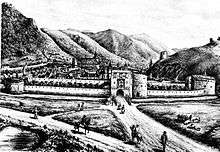
Germans living in Brașov were mainly involved in trade and crafts. The location of the city at the intersection of trade routes linking the Ottoman Empire and Western Europe, together with certain tax exemptions, allowed Saxon merchants to obtain considerable wealth and exert a strong political influence. They contributed a great deal to the architectural flavor of the city. Fortifications around the city were erected and continually expanded, with several towers maintained by different craftsmen's guilds, according to the medieval custom. Part of the fortification ensemble was recently restored using UNESCO funds, and other projects are ongoing. At least two entrances to the city, Poarta Ecaterinei (or Katharinentor) and Poarta Șchei (or Waisenhausgässertor), are still in existence. The city center is marked by the mayor's former office building (Casa Sfatului) and the surrounding square (piața), which includes one of the oldest buildings in Brașov, the Hirscher Haus. Nearby is the "Black Church" (Biserica Neagră), which some claim to be the largest Gothic style church in Southeastern Europe.
In 1689, a great fire destroyed the walled city almost entirely, and its rebuilding lasted several decades.
Besides the German (Saxon) population living in the walled city and in the northern suburbs, Brașov had also a significant Romanian and Bulgarian population (living in the Șchei district), and also some Hungarian population (living in the Blumăna district). The cultural and religious importance of the Romanian church and school in Șchei is underlined by the generous donations received from more than thirty hospodars of Moldavia and Wallachia, as well as that from Elizabeth of Russia. In the 17th and 19th centuries, the Romanians in Șchei campaigned for national, political, and cultural rights, and were supported in their efforts by Romanians from all other provinces, as well as by the local Greek merchant community. In 1838, they established the first Romanian language newspaper Gazeta Transilvaniei and the first Romanian institutions of higher education: Școlile Centrale Greco-Ortodoxe ("The Greek-Orthodox Central Schools", today named after Andrei Șaguna). The Holy Roman Emperor and sovereign of Transylvania Joseph II awarded Romanians citizenship rights for a brief period during the latter decades of the 18th century.
In 1850, the town had 21,782 inhabitants: 8,874 (40.7%) Germans, 8,727 (40%) Romanians, 2,939 (13.4%) Hungarians.[19] In 1910 there were 41,056 inhabitants: 10,841 (26.4%) Germans, 11,786 (28.7%) Romanians, 17,831 (43.4%) Hungarians.[19]
On 29 August 1916, during the First World War, the Romanian Army occupied Brașov. Romanian troops entered the city at around five o'clock p.m. and paraded towards the city square. Romanian rule over the city lasted until early October, when the area was retaken by the Central Powers in the Battle of Brassó (7-9 October 1916).[20] The Romanian mayor installed during the brief Romanian occupation was Gheorghe Baiulescu. His term lasted from 29 August, when the city was occupied by the Romanian Army, until 8 October – the height of the Battle of Brașov. On 9 October, at the end of the battle, the previous mayor (Karl Ernst Schnell) was reinstated.[21]
In 1918, after the Proclamation of the Union of Alba Iulia, adopted by Deputies of the Romanians from Transylvania and supported by Deputies of the Saxons from Transylavania, they all voted to be a part of Romania, and declared their allegiance to the new Romanian state. The inter-war period was a time of flourishing economy and cultural life in general, which included the Saxons in Brașov as well. However, at the end of World War II many ethnic Germans were forcibly deported to the Soviet Union. A majority of them emigrated to West Germany after Romania became a democratic country.
The first Jewish community in Brașov was established in 1828, joining the Neolog association in 1868. Orthodox Jews founded their religious organization in 1877. The Neolog synagogue, seating 800, was built between 1899–1905. During the interwar period, the communities had separate institutions, but opened a jointly managed school in 1940. Zionist organizations appeared already in 1920. By 1930, Jews numbered 2594 individuals, or 4% of the total population. In autumn 1940, during the National Legionary State, the antisemitic Iron Guard nationalized all Jewish institutions and seized most shops owned by Jews. In 1941, Jews were drafted for service in forced labor battalions. Those from throughout southern Transylvania were concentrated in Brașov; a further 200 refugees came from Ploiești. In August 1942, 850 Jews between the ages of 18 and 50 were drafted into labor battalions and ordered to work in Brașov, while others were sent to Predeal and Bran. In spring 1943, 250 youths were sent to Suraia camp to build fortifications. After the King Michael Coup of August 1944, the labor battalions were reduced to 250-300 while most of the Jews managed to obtain their freedom. In 1945–1946, the Jewish population increased to 3500.[22]
Like many other cities in Transylvania, Brașov is also home to a significant ethnic Hungarian minority.
During the communist period, industrial development was vastly accelerated. Under Nicolae Ceaușescu's rule, the city was the site of the 1987 Brașov strike. This was brutally repressed by the authorities and resulted in numerous workers being imprisoned.
Economy

Industrial development in Brașov started in the inter-war period, with one of the largest factories being the airplane manufacturing plant (IAR Brașov), which produced the first Romanian fighter planes used during World War II. After signing the armistice with USSR on September 12, 1944, the factory started repairing trucks, and in October 1945 it began manufacturing agricultural tractors. IAR 22 was the first Romanian-made wheeled tractor. In 1948 the company was renamed "Uzina Tractorul Brașov" known internationally as Universal Tractor Brașov. A big part of the factory was demolished during 2013 and 2014 giving way to buildings, shopping mall an recreation parks. Aircraft manufacturing resumed in 1968 at first under the name ICA and then under its old name of IAR at a new location in nearby Ghimbav.
Industrialization was accelerated in the Communist era, with special emphasis being placed on heavy industry, attracting many workers from other parts of the country. Heavy industry is still abundant, including Roman, which manufactures MAN AG trucks as well as native-designed trucks and coaches. Although the industrial base has been in decline in recent years, Brașov is still a site for manufacturing hydraulic transmissions, auto parts, ball-bearings, construction materials, hand tools, furniture, textiles and shoe-wear. There is also a large brewery.
Demographics
Brașov has a total population of 253,200 (2011 census). Its ethnic composition includes:
- Romanians: 208,019 (91.3%)
- Hungarians: 16,172 (7.1%)
- Germans (Transylvanian Saxons): 1,079 (0.5%)
- Romani people: 916 (0.4%)
- Other ethnicities: 1,037 (0.7%)
In 2005, the Brașov metropolitan area was created. With its surrounding localities, Brașov had 369,896 inhabitants as of 2011.[7]
| Historical population of Brasov | ||
| Year | Population | %± |
|---|---|---|
| 1890 | 30,781 | — |
| 1900 | 34,511 | 12.1% |
| 1910 census | 41,056 | 18.9% |
| 1930 census[23] | 59,232 | 44.2% |
| 1941 census[23] | 84,557 | 42.7% |
| 1948 census[23] | 82,984 | −1.8% |
| 1965 estimate | 140,500 | 69.3% |
| 1975 estimate | 206,156 | 46.7% |
| 1983 estimate | 331,240 | 60.6% |
| 1992 census | 323,736 | −2.2% |
| 2002 census | 284,596 | −12% |
| 2011 census | 253,200 | −11.0% |
Education


Primary Schools
- 30 Primary Schools
High Schools
- Colegiul National "Andrei Șaguna"
- Colegiul National "Dr. Ioan Meșotă"
- Colegiul National de Informatică "Grigore Moisil"
- Colegiul National "Unirea"
- Colegiul National "Johannes Honterus"
- Colegiul Național "Áprily Lajos"
- Liceul "Andrei Muresanu"
- Colegiul de Stiințe ale Naturii "E. Racoviță"
- Liceul "Nicolae Titulescu"
- Liceul de Artă
- Liceul cu Program Sportiv
- Colegiul de stiințe "Grigore Antipa"
- Liceul Teoretic "C. Brancoveanu"
- Seminarul Teologic Liceal Ortodox "D. Staniloaie"
- Colegiul Tehnic "Astra"
- Colegiul Tehnic "Mircea Cristea"
- Colegiul Tehnic "Iosif Silimon"
- Colegiul Tehnic "Sfintii Voievozi"
- Grupul Școlar de Arte si Meserii
- Colegiul Tehnic "Remus Radulet"
- Colegiul Tehnic Feroviar
- Grupul Scolar Industrial Auto
- Colegiul Tehnic "Maria Baiulescu"
- Grupul Scolar Ind. de Constr. Montaj
- Colegiul National Ec. "Andrei Barseanu"
- Grupul Scolar Silvic "Dr. N. Rucareanu"
- Grupul Scolar de Turism si Alim. Publica
- Liceul "FEG"
- Liceul "Europa Unita"
Universities:
- Transylvania University of Brașov
- George Barițiu University
- Spiru Haret University
- Christian University Dimitrie Cantemir
- Academia Fortelor Aeriene Henri Coanda
- Fundatia Univ. Sf. Apostoli Petru si Pavel
- Universitatea Sextil Puscariu
- Universitatea Romano Canadiana
- American Hotel Academy
Transportation
The Brașov local transport network has around 50 bus and trolleybus lines. There is also a regular bus line serving Poiana Brașov, a nearby winter resort. All are operated by RAT Brașov. Because of its central location, the Brașov railway station is one of the busiest stations in Romania with trains to/from most destinations in the country served by rail.
The construction of Brașov Airport[24] was initiated by Intelcan Canada on April 15, 2008. Although construction was planned to be finalized in 24 to 30 months, works have lagged and there is no term by which it will be operational. The project consists of a terminal capable of handling 1 million passengers per year and a 2,800-metre-long (9,200-foot) runway. The A3 highway is also planned to pass the city. However, there is no foreseeable date for starting construction.
Tourism

With its central location, Brașov is a suitable location from which to explore Romania, and the distances to several tourist destinations (including the Black Sea resorts, the monasteries in northern Moldavia, and the wooden churches of Maramureș) are similar. It is also the largest city in a mountain resorts area. The old city is very well preserved and is best seen by taking the cable-car to the top of Tâmpa Mountain.
Temperatures from May to September fluctuate around 23 °C (73 °F). Brașov benefits from a winter tourism season centered on winter sports and other activities. Poiana Brașov is the most popular Romanian ski resort and an important tourist center preferred by many tourists from other European states.
The city also has several restaurants that serve local as well as international cuisine (e.g. Hungarian and Chinese). Some of these are situated in the city center.
Sights
- Biserica Neagră ("The Black Church"), a celebrated Gothic site – the building dates from 1477, when it replaced an older church (demolished around 1385). It acquired the name after being blackened by smoke from the 1689 great fire.
- Franciscan Church, Brașov
- Casa Sfatului ("The mayor's former office building"). The administration for Brașov was here for more than 500 years.
- Biserica Sf. Nicolae (St. Nicholas Church), dating back to the 14th century.
- The First Romanian School, a museum with the first Romanian printing press among many other firsts.
- The Rope Street, the narrowest street in Romania.
- Black Tower, Old City Watch Tower.
- White Tower, Old City Watch Tower.
- Șchei, the historically Bulgarian but then Romanian neighborhood outside of the old walled city.
- Catherine's Gate, the only original city gate to have survived from medieval times.
- Șchei Gate, next to Catherine's Gate, built in 1827.
- Tâmpa, a small mountain in the middle of the city (900m above sea level), a sightseeing spot near the old city center.
- The "Brașov Citadel Fortress" – Cetățuia Brașovului
- The nearby Bran Castle, attracting many fans of Dracula and often (but incorrectly) said to have been the home of Vlad the Impaler.[25]
- Poiana Brașov, mainly a ski resort but also a sightseeing spot.
- Râșnov Fortress, above the nearby town of Râșnov, is a restored peasant fortress
- Prejmer Fortress, in the nearby commune of Prejmer
- Saint George's Church, Brașov
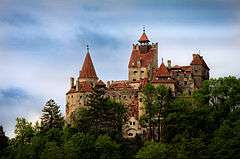 Bran Castle, situated in the immediate vicinity of Brașov
Bran Castle, situated in the immediate vicinity of Brașov White Tower with Mount Tâmpa in the background
White Tower with Mount Tâmpa in the background
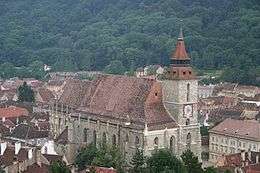 Black Church
Black Church- City center seen from Mount Tâmpa
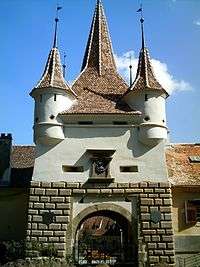
International relations
Twin towns and Sister cities
Brașov is twinned with:
Sport

The city has a long tradition in sports, the first sport associations being established at the end of the 19th century (Target shooting Association, Gymnastics School). The Transylvanian Sports Museum is among the oldest in the country and presents the evolution of consecrated sports in the city. During the communist period, universiades and Daciads were held, where local sportsmen were obliged to participate. Nowadays, the infrastructure of the city allows other sports to be practiced, such as football, rugby, tennis, cycling, handball, gliding, skiing, skating, mountain climbing, paintball, bowling, swimming, target shooting, basketball, martial arts, equestrian, volleyball or gymnastics. Annually, at "Olimpia" sports ground, the "Brașov Challenge Cup" tennis competition is held.
Colțea Brașov was the football champion in 1928, managing a second place in 1927, in its only 10 years of existence (1921–1931). It was succeeded by Brașovia Brașov.
Between 17 and 22 February 2013, the city hosted the 2013 European Youth Winter Olympic Festival.
As of 2012, Brașov is hosting two trail semi-marathons: the Semimaraton Intersport Brașov (held in April) and the Brașov International Marathon (held in April or May).
In November 2013, Brașov submitted their bid for the 2020 Winter Youth Olympics. They were up against Lausanne, Switzerland to be awarded the event. In December that year, the city was signed the Youth Olympic Game Candidature Procedure. The host city was to be announced in July 2015,[29] in which Lausanne was selected.
Local teams
- SR Brașov – football club
- ASC Corona Brașov – football club, women's handball and ice hockey club
- CSU Brașov – basketball team
- CFR Brașov – rugby football club
Sports venues
- Planned
- Brașov Arena (23,000 seats) – planned football stadium on the site of the former Municipal Stadium
- Existing
- Silviu Ploeșteanu Stadium (8,500 seats) – built in 1960 for football, floodlights were installed in 2009
- Dumitru Popescu Colibași Sports Hall (2,300 seats) – built around 1970 for indoor sports: handball, basketball, volleyball, sometimes others
- Brașov Olympic Ice Rink (2,000 capacity: 1,600 seated, 400 standing) – inaugurated on February 18, 2010, used mainly for ice hockey and public skating
- Demolished
- Municipal Stadium (30,000 capacity) – built in 1975, used for 1 May and 23 August parades, rarely used for football matches (demolished in 2008)
- Others
- Paradisul Acvatic - aquatic complex with 40m long swimming pool and three jumping platform (1 m, 3 m, 5.20 m)
Notable events
- Tess Rally Brașov – The local round in the Romanian Rally Championship
- BRD Brașov Challenger – A tennis tournament, part of the ATP Challenger Tour
- Braşov International Marathon – Marathon – 42 km Course, Half-Marathon – 21 km Course 10,7 km & Team Run + 5,7 km Course
Media
The city of Brașov is home to several local media publications such as Transilvania Express, Monitorul Express, Bună Ziua Brașov or Brașovul Tău.[30] Also, several local television stations exist, such as RTT, MIX TV and Nova TV.[31]
Gallery
Notes
- "Results of the 2016 local elections". Central Electoral Bureau. Retrieved 3 April 2020.
- "Populaţia stabilă pe judeţe, municipii, oraşe şi localităti componenete la RPL_2011" (in Romanian). National Institute of Statistics. Retrieved 8 March 2017.
- "Populația României pe localitati la 1 ianuarie 2016" (in Romanian). INSSE. 6 June 2016. Archived from the original on 2017-10-27. Retrieved 3 November 2017.
- "Brasov". The American Heritage Dictionary of the English Language (5th ed.). Boston: Houghton Mifflin Harcourt. Retrieved 10 May 2019.
- "Braşov" (US) and "Braşov". Oxford Dictionaries UK Dictionary. Oxford University Press. Retrieved 10 May 2019.
- "Braşov". Merriam-Webster Dictionary. Retrieved 10 May 2019.
- "Population at 20 October 2011" (in Romanian). INSSE. 5 July 2013. Retrieved 5 July 2013.
- Orbán Balázs (1868). A Székelyföld leírása VI. Pest.
- Dragoș Moldovanu, Toponimie de origine romană în Transilvania și în sud-vestul Moldovei, Anuarul de lingvistică și istorie literară, XLIX-L, 2009–2010, Bucuresti, p 59
- Alexandru Madgearu, "Români și pecenegi în sudul Transilvaniei" Archived 2010-01-08 at Wikiwix, Editura Economică, 2005, ISBN 973-709-158-2
- Drăganu, Nicolae "Români in veacurile IX—XIV pe baza toponimiei şi a onomasticei" (The Romanians in the 9th - 14th Centuries According to Toponymy and Onomastics), Imprimeria Naţionala, 1933, București, p.560
- Austerlitz, Robert ""Brasov-Brasso'-Kronstadt-Berries and Bushes", in Xenia Slavica; Papers Presented to Gojko Ruzicic on the Occasion of his Seventy-Fifth Birthday, 2 February 1969, Rado Lencek and Boris O. Unbegaun, eds. (The Hague: Mouton, 1957), p.19
- J. G. Th. Graesse: Orbis Latinus, G. Schönfeld, Dresden 1861, urn:nbn:de:s2w-3093:{{{2}}} (html, with alphabetical search index).
- "Brasov – Travel To Romania". www.traveltoromania.com. Archived from the original on 2007-10-10.
- "Climate: Brașov". Climate-Data.org. Archived from the original on February 2, 2018. Retrieved February 2, 2018.
- Coles & Harding 1979, p. 140.
- Coles & Harding 1979, p. 410.
- Mediaeval studies, Volumes 17-18, Pontifical Institute of Mediaeval Studies, 1955, Toronto, Canada, An annual journal of scholarship, History, ISSN 0076-5872
- "Erdély etnikai és felekezeti statisztikája". varga.adatbank.transindex.ro. Archived from the original on 2007-12-19.
- Michael B. Barrett, Indiana University Press, 2013, Prelude to Blitzkrieg: The 1916 Austro-German Campaign in Romania, pp. 26 and 122
- "PRIMARII BRAȘOVULUI (in Romanian), p. 4" (PDF). Archived from the original (PDF) on 2017-06-30. Retrieved 2019-01-01.
- Shmuel Spector, Geoffrey Wigoder (eds.), The Encyclopedia of Jewish Life Before and During the Holocaust: A-J, p. 182. NYU Press, 2001, ISBN 978-081-4793-76-3
- Populatia RPR la 25 ianuarie 1948, p. 14
- "Website of the Brașov Airport". Archived from the original on 2017-10-17.
- Middleton, Christopher (11 May 2014). "Buy a stake in Dracula's castle". Daily Telegraph. Archived from the original on 23 January 2015.
- Tampere – Finlanda Archived 2009-12-29 at the Wayback Machine
- "Sister Cities International (SCI)". Sister-cities.org. Archived from the original on 2015-06-13. Retrieved 2013-04-21.
- News Report concerning the Twinning with Linz Archived 2015-02-04 at the Wayback Machine
- "Press releases". 8 January 2018. Archived from the original on 6 June 2014.
- "Archived copy" (PDF). Archived from the original (PDF) on 2006-02-14. Retrieved 2014-10-18.CS1 maint: archived copy as title (link)
- "Archived copy". Archived from the original on 2014-10-22. Retrieved 2014-10-18.CS1 maint: archived copy as title (link)
References
- Coles, John; Harding, A.F. (1979). The Bronze Age in Europe pages 140. Routledge. ISBN 978-0-416-70650-5.CS1 maint: ref=harv (link)
- "O istorie a Brașovului" ("A history of Brasov") – Ion Dumitrașcu, Mariana Maximescu, Phoenix, Brașov, 2001
- "Fortificația dacică de la Brașov – Pietrele lui Solomon" ("The Dacian citadel from Brașov – Pietrele lui Solomon"), Fl. Costea, CumidavaXX, Brașov, 1996
- "Săpăturile de salvare de pe dealul Șprenghi" ("The diggings for saving [the archaeological evidences] from Șprenghi Hill" – the hill was a quarry) A. Alexandrescu, N. Constantinescu, București, 1959
- "Die spätneolitischen Ansiedlungen mit bemalter Keramik aus oberem Laufe des Altflusses", J. Teutsch, Mitteilungen der Prehistorischen Komision, I, Wien.
Further reading
- "Kronstadt", Austria-Hungary, Including Dalmatia and Bosnia, Leipzig: Karl Baedeker, 1905, OCLC 344268, OL 20498317M
External links
| Wikimedia Commons has media related to Brașov. |
| Wikivoyage has a travel guide for Brașov. |
| Wikisource has the text of the 1911 Encyclopædia Britannica article Brassó. |
- City Hall Official Website
- Tourism Official Website
- German Cultural Center, kulturzentrum-kronstadt.ro
- Art Museum Brașov, muzeulartabv.ro

